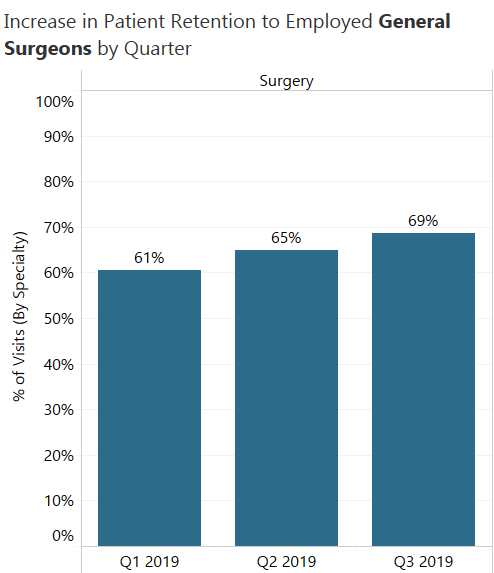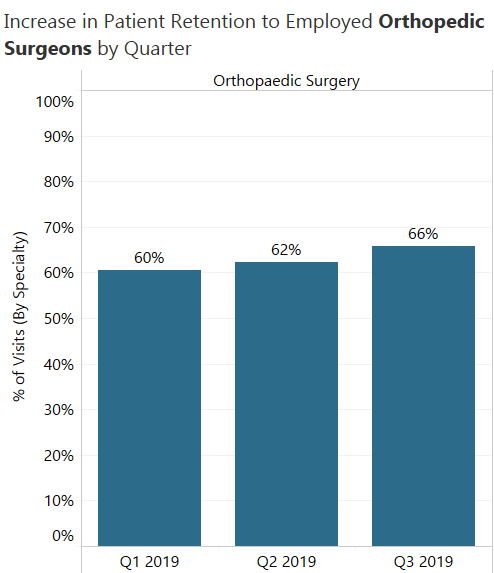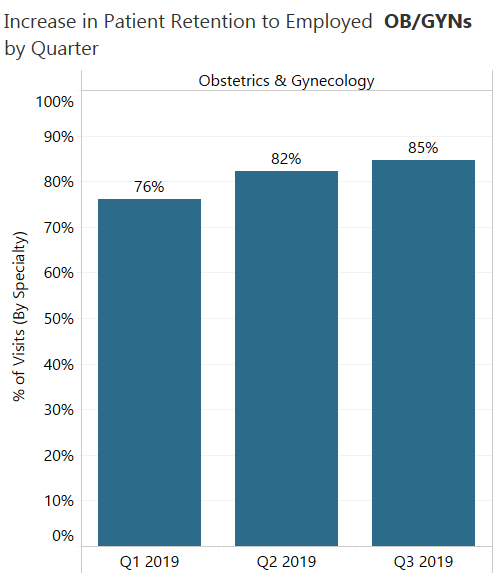
|
Download a PDF Version to Share With Your Team |
Patient Retention Outcomes
HSG’s client, an independent hospital on the outskirts of a highly competitive market, has historically struggled losing patients to tertiary health systems, specifically for high-acuity procedures. Utilizing HSG Physician Network Integrity Analytics® and our Patient Flow analytic approach, which measures physician referral patterns in customizable time frames, allowed the organization to measure and then manage patient leakage volumes for their core service lines. The hospital has increased patient retention for orthopedics, general surgery, and women’s health (core service lines) by 6%, 8%, and 9% over the past 9 months.
The hospital has invested a great deal into building their employed physician network by recruiting incremental specialists and primary care providers to the market. A key initiative to support their investment was on maximizing patient retention within the employed network and closely aligning employed primary care providers with employed specialists. The hospital had a blind spot as to specific patient leakage volumes.
Their ability to adequately measure patient leakage, engage physicians in patient retention initiatives, and operationalize referral leakage metrics throughout the organization have led to rapid return on investment.
Patient Retention Keys to Success
1: Referral Data Management
HSG’s client had historically only tried to measure patient leakage and physician referrals through their Electronic Medical Record (EMR). This never provided the client a full picture of patient leakage because the EMR is unable to adequately track services delivered outside of the client organization. Thus, the client engaged HSG to utilize all-payer claims data to monitor patient leakage on an ongoing basis through HSG Physician Network Integrity Analytics®.
HSG analyzed data using the HSG Patient Flow analytic approach to measure and track patient volumes from employed primary care providers to any specialist (employed or not) in a 90-day timeframe. Key metrics were developed for core service lines and reported on quarterly. Patient volumes from an employed primary care provider to employed general surgeons increased from 61% to 69% in the three quarters measured thus far. Volume to employed orthopedists and women’s health providers saw similar improvement moving from 60% to 66% and 76% to 85%, for each specialty respectively.
While the patient leakage measurement step seems simple, HSG sees many organizations struggling to adequately measure patient retention and leakage on an on-going basis due to EMR or data access limitations.



2: Physician Communication and Engagement
Educating and engaging physicians in patient leakage data discussions has been core to the success of increasing patient retention. Joint problem solving, and not accusatory finger-pointing on patient leakage, between administration and physicians led to informative meetings that identified common reasons patients were leaving the hospital network. Often times, these reasons were operational in nature and could be reconciled by identifying action-oriented next steps.
Additionally, many primary care physicians were often unaware of where patients ultimately received services. Once physicians began to understand where patients were going for procedures, they were better able to educate patients on local service capabilities.
3: Referral Data Operationalization
Operationalizing referral data reported by HSG and updated quarterly at the primary care and specialty practice manager levels was the last key to success. Practice managers, physician liaisons, and service line leaders joint review of the data proved valuable. This group was able to provide a unique perspective that was helpful to physicians. Management level personnel were often unsurprised by data outcomes and had immediate ideas for patient leakage gaps. The issues were most frequently operational and could be overcome.
In addition to being able to adequately measure patient leakage, which most organizations are not capable, engaging physicians and management personnel around patient leakage concerns often leads to great insights where real change can be made.
Learn More About HSG’s Patient Flow Analytic Capabilities
To learn more about HSG’s approach to patient leakage measurement and get a complementary 90-day Patient Flow report for providers in your employed network, contact DJ Sullivan.
